#Translate Text from Images
Explore tagged Tumblr posts
Text
How to Translate Text from Images — Trulinco

In our increasingly interconnected world, the ability to seamlessly translate text from images has become an essential skill, catering to the diverse linguistic needs of individuals and businesses alike. As we navigate the vast expanse of information available online, language should never be a barrier. This article delves into the vital realm of translating text from images, exploring the Image Translation software that empower us to break through linguistic confines.
The Digital Age Dilemma
The digital age has ushered in a staggering amount of information, creating a global village where ideas, cultures, and knowledge intertwine. However, this digital utopia brings along its own set of challenges, prominently among them being language barriers. With content pouring in from every corner of the globe, the need for seamless language translation has never been more pronounced.
Seamless Language Translation
Imagine stumbling upon a captivating image that encapsulates information crucial to your interests or work, only to find that the accompanying text is in a language alien to you. This is where the importance of translating text from images becomes evident. It’s not merely a convenience but a necessity in a world where collaboration, research, and cultural exchange thrive on effective communication.
The Role of OCR Technology
Enter Optical Character Recognition (OCR) technology, the unsung hero behind the scenes of image translation. OCR technology has evolved to decipher and convert text embedded in images into machine-readable text. It’s the engine that powers image-to-text conversion, enabling us to bridge language gaps seamlessly. As we journey through this article, we’ll unravel the capabilities of OCR and explore how it contributes to unlocking the potential of image translation tools.
So, buckle up as we embark on a journey to unravel the intricacies of translating text from images, unveiling the power of OCR in a digital landscape where language should never be a barrier.
Understanding Image Translation Tools
As we delve into the realm of image translation, it’s imperative to acquaint ourselves with the leading tools that pave the way for linguistic fluidity across borders. Let’s embark on a journey through the top competitors in the image translation arena, dissecting their strengths, weaknesses, and unique features.
1. Trulinco: Navigating Challenges in Image Translation
Trulinco, a contender in the image translation landscape, presents its unique set of features and challenges. Understanding its weaknesses is essential for users evaluating its suitability for their specific needs.
Weaknesses:
Limited Recognition and Popularity: Trulinco may face challenges associated with limited recognition and popularity in comparison to more established competitors. Users accustomed to widely recognized platforms might hesitate to adopt a less-known tool.
Language Support: The effectiveness of Trulinco could be contingent upon its language support. Users seeking translation capabilities for less common languages may encounter limitations, impacting the tool’s overall utility.
Advanced Features: In comparison to some industry leaders, Trulinco might lack certain advanced features. Users requiring a comprehensive set of functionalities for specific use cases may find it less suitable.
Opportunity:
Highlighting Unique Features: Identifying and showcasing Trulinco’s unique features, which set it apart from other tools, can attract users looking for specialized functionalities. This could include any proprietary algorithms or unique approaches to image translation.
Addressing Language Support: Providing transparency about Trulinco’s language support and potential limitations ensures users are aware of its capabilities. Offering guidance on alternative solutions for less supported languages can enhance user satisfaction.
Improving Recognition and Popularity: Proposing strategies for improving Trulinco’s recognition and popularity within the user community will contribute to its broader adoption. Encouraging user reviews and testimonials can also boost confidence in the tool.
Why Translation Automation Is Crucial for Scaling Your SaaS Business? Check Detailed Guide
2. Google Translate: Breaking Language Barriers with Precision
Google Translate stands as a behemoth in the translation landscape, offering users a multifaceted tool capable of translating text from images. Its seamless integration with other Google services and widespread usage make it a go-to for many.
Strengths:
The accuracy of Google Translate is commendable, particularly when dealing with common languages. Its strength lies not only in translation but also in its ability to provide contextually relevant results.
Weaknesses:
However, limitations exist, especially in the context of image translation. The tool may falter with complex images, occasionally misinterpreting nuanced content.
Opportunity:
For users seeking optimal results, a guide on image quality optimization could prove invaluable. Understanding the nuances of image clarity and composition can significantly enhance the accuracy of text translation.
3. Microsoft Translator: Bridging the Language Divide
Microsoft Translator is another heavyweight in the translation arena, offering a diverse set of features, including image translation. With extensive language support and integration with Microsoft Office, it caters to a broad user base.
Strengths:
What sets Microsoft Translator apart is its vast language repertoire and seamless integration with Microsoft’s ecosystem. This makes it a preferred choice for businesses heavily invested in Microsoft products.
Weaknesses:
Despite its strengths, Microsoft Translator may encounter challenges in maintaining context during image translation, leading to potential gaps in understanding.
Opportunity:
To optimise the user experience, exploring the accuracy of translation in different document types could be beneficial. Understanding the tool’s strengths in specific scenarios will guide users in making informed choices.
4. ABBYY FineReader: Precision in Document Translation
ABBYY FineReader, while primarily known for its OCR capabilities, extends its reach into translation. This software is revered for its robust OCR engine and the ability to retain document formatting during translation.
Strengths:
FineReader excels in maintaining document structure, making it a favorite for users dealing with complex documents. Its OCR capabilities ensure a high level of accuracy in image-to-text conversion.
Weaknesses:
However, the learning curve associated with ABBYY FineReader might be steeper for casual users compared to more straightforward online tools.
Opportunity:
Highlighting the detailed steps to optimise ABBYY FineReader for efficient image translation, especially for businesses dealing with intricate documents, can enhance its utility.
5. OnlineOCR: Simplicity at a Cost
OnlineOCR, a web-based tool for image-to-text conversion, attracts users with its simplicity and accessibility. However, certain limitations should be considered.
Weaknesses:
While OnlineOCR provides an easy-to-use platform, its drawbacks include limited language support and potential loss of formatting during the translation process. Users might encounter challenges with more complex documents or less common languages.
Opportunity:
To address these concerns, we can guide users on alternative solutions when dealing with intricate documents or languages not well-supported by OnlineOCR. Exploring how to mitigate potential formatting issues will enhance the overall user experience.
6. i2OCR: User-Friendly, Yet Not Without Faults
i2OCR prides itself on a user-friendly interface and free accessibility. However, its limitations warrant careful consideration.
Weaknesses:
Limited language support and occasional accuracy issues may deter users seeking more reliable and comprehensive solutions. While i2OCR serves its purpose for basic tasks, its effectiveness diminishes in more complex scenarios.
Opportunity:
Addressing common user concerns and providing tips on how to improve accuracy will be instrumental in ensuring users get the most out of i2OCR. Offering alternative solutions for tasks that go beyond its capabilities will further enhance its utility.
Translate from English to Italian with Trulinco? Try Now!
7. Text Fairy (OCR Text Scanner): Mobile Convenience with Constraints
Text Fairy caters to users on the go, offering mobile convenience for image text extraction. However, its limitations become apparent in comparison to more feature-rich desktop solutions.
Weaknesses:
While Text Fairy excels in mobile functionality, it may lack the advanced features and language support available in desktop counterparts. Users relying solely on mobile solutions may face constraints in certain scenarios.
Opportunity:
Highlighting the advantages of mobile OCR, particularly for users who prioritise on-the-go functionality, will provide clarity on Text Fairy’s niche. Offering insights into scenarios where a combination of mobile and desktop solutions might be optimal can enhance user experience.
8. Online Image Translator by ImTranslator: Balancing Integration with Drawbacks
ImTranslator, a web-based image translation tool, offers integration with other translation services. However, users should be aware of its limitations.
Weaknesses:
Potential loss of formatting and limited functionality in offline scenarios are notable drawbacks. ImTranslator’s reliance on online connectivity might be a hindrance for users in areas with limited internet access.
Opportunity:
Guiding users on the integration possibilities and explaining how to mitigate formatting issues will be valuable. Additionally, addressing the tool’s dependency on online access can help users make informed decisions based on their specific requirements.
9. Yandex.Translate: A Powerful Contender with Room to Grow
Yandex.Translate, with its advanced language support and integration with other Yandex services, stands as a robust tool. However, it faces challenges associated with global recognition.
Weaknesses:
Despite its capabilities, Yandex.Translate is less known globally compared to industry giants like Google Translate. Its limited popularity may be a hurdle for users accustomed to widely recognized translation platforms.
Opportunity:
Exploring and showcasing the unique features of Yandex.Translate, along with its advantages in specific scenarios, will help elevate its recognition. Emphasising its strengths in certain language pairs or industries can attract users seeking specialized solutions.
Looking for Best Yandex Translate Alternative? Try Trulinco
10. OneNote’s Image to Text: A Microsoft Ecosystem Exclusive
OneNote’s Image to Text feature offers image translation within the Microsoft ecosystem, providing a seamless experience for users deeply integrated into Microsoft services.
Weaknesses:
Exclusive to Microsoft users, OneNote’s Image to Text may pose accessibility challenges for those outside the Microsoft ecosystem. Potential loss of formatting could also be a consideration for users dealing with intricate documents.
Opportunity:
Highlighting the advantages of using OneNote within a collaborative environment and addressing the limitations for non-Microsoft users will guide users in making informed decisions. Providing tips to preserve formatting during image translation will further enhance its utility.
11. Capture2Text: Lightweight Efficiency with Fewer Features
Capture2Text stands out as a lightweight OCR tool, providing instant text translation with customizable hotkeys. However, its simplicity comes with trade-offs.
Weaknesses:
While efficient and fast, Capture2Text may lack the extensive features found in more comprehensive tools. Users requiring advanced functionalities or broader language support may find it less suitable for their needs.
Opportunity:
Showcasing scenarios where Capture2Text’s lightweight nature is advantageous, such as quick, on-the-spot translation, will help users understand its niche. Offering insights into when a more feature-rich tool might be necessary ensures users can make informed choices based on their specific requirements.
Here is Easiest Way to Translate Images in 2024 check Beginner’s Guide
Optimization Tips for Image Translation
Having explored the strengths and weaknesses of various image translation tools, it’s now crucial to equip users with optimization tips. Enhancing the image quality and understanding the intricacies of OCR technology are pivotal for achieving accurate and reliable text translation from images.
1. Image Quality Matters: A Guide to Clarity
Understanding the Impact:
The clarity and quality of the image significantly influence the accuracy of OCR and, consequently, the translation output. Blurry, distorted, or poorly lit images may lead to misinterpretations and errors in text extraction.
Optimization Tips:
Resolution Matters: Use high-resolution images to capture finer details, ensuring characters are distinct and easily recognizable.
Contrast Enhancement: Adjust contrast to create a clear distinction between text and background, aiding OCR algorithms in accurate recognition.
Well-Lit Environment: Capture images in well-lit conditions to minimize shadows and enhance overall visibility.
2. OCR Engines: Choosing the Right Powerhouse
Comparative Analysis:
Different image translation tools employ distinct OCR engines, each with its strengths and limitations. Users should be aware of the OCR engine used by their chosen tool and its performance in various scenarios.
Optimization Tips:
Research OCR Engines: Understand the OCR engine employed by the selected tool. Some engines excel in specific languages, fonts, or document types.
Trial and Error: Experiment with different OCR engines to determine the one yielding the best results for your specific image translation needs.
Regular Updates: Keep abreast of OCR engine updates to benefit from improved recognition capabilities and bug fixes.
3. User-Friendly Approaches for Better Results
Simplicity vs. Complexity:
While some users prefer straightforward, user-friendly tools, others may opt for more complex solutions. Tailoring the approach based on user preferences and the nature of the task is key to achieving optimal results.
Optimization Tips:
User Training: Provide tutorials or guides for users to navigate complex tools effectively. Simplify the learning curve for tools with advanced features.
Feedback Mechanism: Encourage users to provide feedback on the tool’s performance, helping developers refine algorithms and enhance user experience.
Customizable Settings: Tools with customizable settings empower users to adapt the tool to their specific requirements, improving overall efficiency.
4. Business Solutions: Addressing Corporate Challenges
Challenges in a Corporate Environment:
Businesses often deal with complex business documents translation, multiple languages, and collaborative workflows. Choosing image translation tools that cater to these specific challenges is crucial for seamless integration.
Optimization Tips:
Collaboration Integration: Select tools that integrate well with collaborative platforms, streamlining document sharing and translation workflows.
Language Portfolio: Opt for tools with extensive language support, especially if your business operates in a multilingual environment.
Formatting Preservation: Ensure the chosen tool retains document formatting during translation, minimising post-translation adjustments.
In optimising image translation, users can navigate the complexities of OCR technology and choose tools that align with their specific needs. These tips serve as a guide for achieving optimal results, ensuring a smooth and accurate translation experience from images.
Is there any call translation app? Try Trulinco, a real-time language translation app
Practical Applications and Use Cases
Understanding the practical applications and real-world use cases of image translation tools is paramount for users seeking to leverage these technologies effectively. Let’s explore scenarios where image translation can be a game-changer, shedding light on the diverse applications that cater to different user needs.
1. Image Translation in Academia: Breaking Language Barriers in Research
Scenario:
Imagine a researcher coming across an insightful academic paper, yet hindered by a language barrier. Image translation tools can be invaluable in extracting key information from figures, charts, and textual content, facilitating cross-cultural collaboration in academic pursuits.
Optimization Tips:
Precision in Graphical Content: Choose tools with advanced OCR capabilities to accurately extract information from complex charts and diagrams.
Multilingual Collaboration: Opt for tools supporting a wide range of languages to cater to the diverse international academic community.
2. Global Business Communications: Enhancing Multilingual Collaboration
Scenario:
In a global business environment, communication across linguistic boundaries is a common challenge. Image translation tools empower businesses to swiftly translate documents, ensuring that crucial information is accessible to teams irrespective of their native languages.
Optimization Tips:
Integration with Collaboration Platforms: Select tools that seamlessly integrate with business collaboration platforms, fostering efficient communication.
Document Formatting Preservation: Prioritize tools capable of preserving document formatting to maintain professionalism in business communications.
Looking for Best Translation Tool for Your Business? Try Trulinco
3. Cultural Heritage Preservation: Translating Historical Documents
Scenario:
Preserving cultural heritage often involves dealing with historical documents in various languages. Image translation tools play a vital role in translating ancient manuscripts, enabling historians and archivists to decipher and understand the content.
Optimization Tips:
OCR Accuracy in Old Scripts: Choose tools with OCR engines optimised for recognizing characters in historical scripts and fonts.
Language Support for Archival Documents: Opt for tools with support for lesser-known languages to cater to diverse historical materials.
4. Mobile OCR for Travelers: Instant Language Assistance On-the-Go
Scenario:
Travellers navigating foreign environments may encounter signs, menus, or documents in unfamiliar languages. Mobile OCR tools become a handy companion, instantly translating text from images and providing travellers with the information they need.
Optimization Tips:
Offline Functionality: Select mobile OCR tools that offer offline functionality, crucial in areas with limited or expensive internet access.
User-Friendly Interfaces: Opt for tools with intuitive interfaces for quick and hassle-free translations on the go.
5. Language Learning Support: Enhancing Vocabulary with Visuals
Scenario:
Language learners often supplement their studies with real-world examples. Image translation tools aid language learners by providing translations for words found in images, reinforcing vocabulary acquisition with visual context.
Optimization Tips:
Contextual Learning: Choose tools that offer contextual translations, allowing language learners to understand words in various contexts.
Pronunciation Assistance: Opt for tools that provide audio pronunciation, aiding language learners in mastering correct pronunciation.
Understanding the diverse applications of image translation tools enables users to tailor their choices based on specific needs, fostering efficiency and effectiveness in various scenarios. Whether in academia, business, cultural preservation, travel, or language learning, image translation tools prove to be versatile assets in breaking language barriers.
Confused between Trulinco vs Google vs DeepL? Check Comprehensive Comparison
Conclusion
In the ever-evolving landscape of image translation, where language barriers intersect with technological advancements, the journey through the tools and strategies available has been enlightening.
We’ve explored the strengths and weaknesses of prominent image translation tools, delving into optimization tips for a seamless user experience. Understanding the practical applications across diverse scenarios underscores the significance of these tools in various aspects of our lives.
To Integrate Trulinco, real time language Translation software with advance features, Contact Us Now!
Originally published at https://www.trulinco.com on January 9, 2024.
0 notes
Text










i've been watching a lot of Gumby, so here's my pitch for an episode where Gumby & Pokey visit Hell
#makeaterriblecomicday2025#make a terrible comic day#makeaterriblecomicday#gumby#the divine comedy#the inferno#dante's inferno#comics#fanart#crossover#image ID in alt text#lonely dog draws#any text that is directly from the book is henry wadsworth longfellow's translation#(the block of text as gumby says 'well if that's our only option...' and the placard at the entrance of hell)#i would defo change things about this‚ but ah well. in the spirit of the day: it is what it is
481 notes
·
View notes
Text


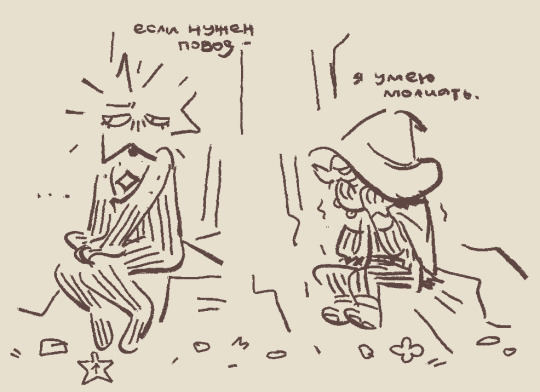










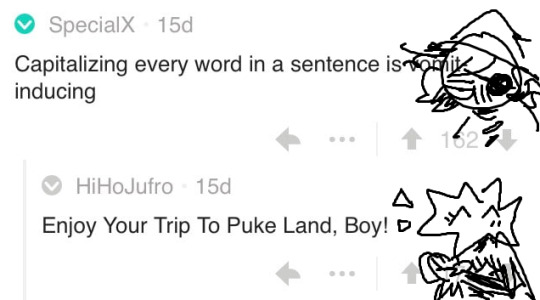

rawdogged the whole isat in three days and then went on a drawing spree
#in stars and time#isat spoilers#isat siffrin#isat loop#sorry others but theres only a glimpse of you in this#isat fanart#my art#the first 3 images are song lyrics. болливуд by краснознамённая дивизия имени моей бабушки#'the filming shift doesn't know when to end'#'i am to blame'#'if you want a reason - i can hold my tongue'#translated the text on the images respectively#the sif with the fangs is not really a vampire i just wanted to give him fangs because i have them#for fun#there are also some loop gijinkas for the aftermath of the game#i think they'd like to change it up a bit and resemble sif a bit less if they can help it#grow the hair out a bit and keep it white#alright im done ramblin#hi guys#also the last image is from today and the others are all a couple days old
347 notes
·
View notes
Text
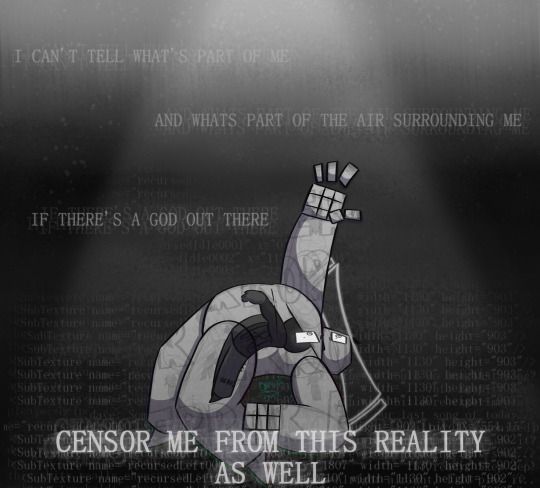
dont ask me how, i dont know either
#ori's doodles#dave and bambi#dave and bambi recurser#dnb recurser#fnf recurser#did you guys know that in the late halloween mod recurser is the one who censored gevil or however the fuck you spell their name?#the text on the censorship image used while gevil transforms says This exact text here#ty t5 for giving the translation lmao#i'll cross post my other doodles from twitter soon dw#do i cw for dereality themes..?
52 notes
·
View notes
Text
kaiaŋ! this is the script for my new conlang din ɛgwa :D it's written top to bottom, left to right. everything is connected, so you could technically write an entire book in one long line if you had a really long strip of paper. theres a round and an angular version.
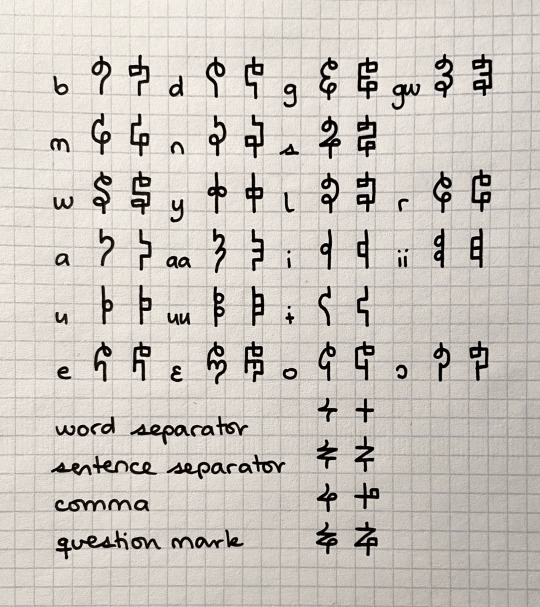
(<gw> is /gʷ/, <y> is /j/, <r> is /ɹ/, <VV> is /Vː/)
and here's a little text written in the script! at the points where one line ends and where another begins is a little dot to show continuity.
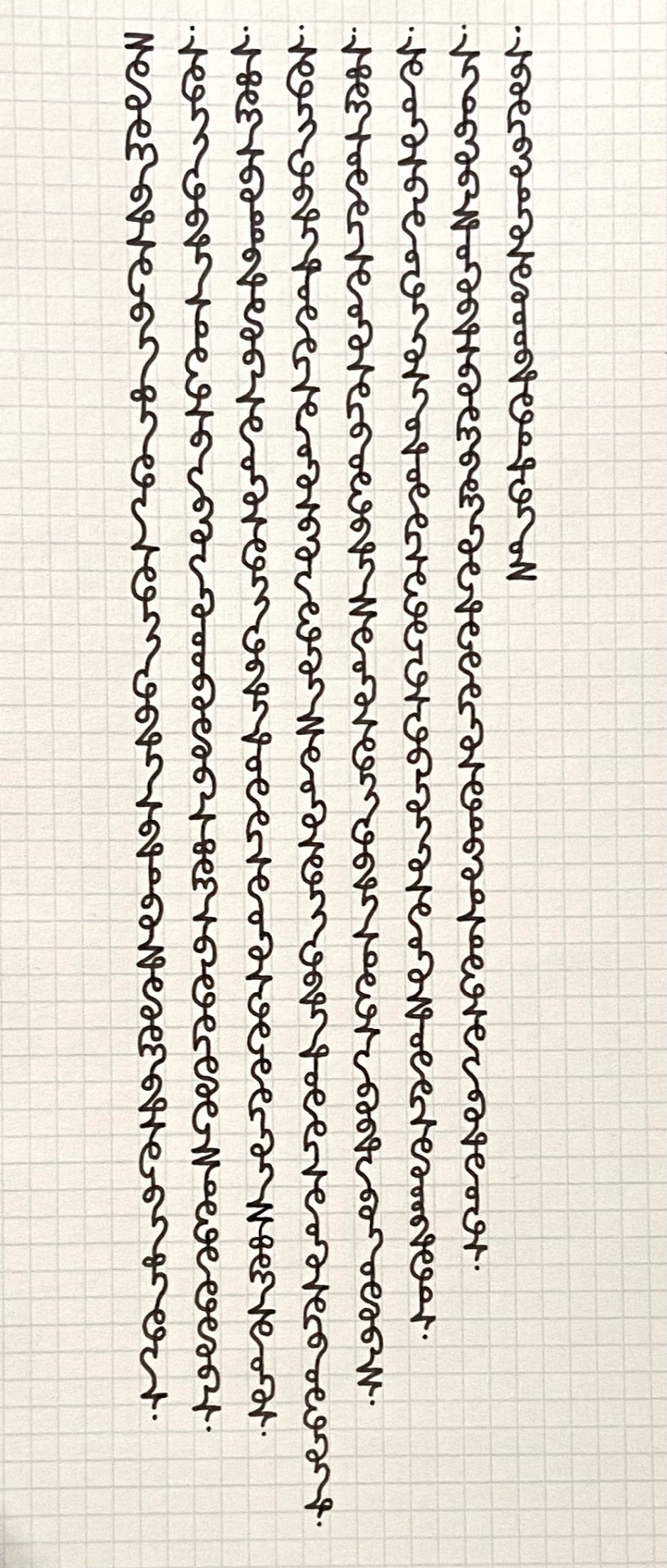
Translation under the cut! thanks for reading :)
What did this player dream? This player dreamed of sunlight and trees. Of fire and water. It dreamed it created. And it dreamed it destroyed. It dreamed it hunted, and was hunted. It dreamed of shelter. Does it know that we love it? That the universe is kind? Sometimes, through the noise of its thoughts, it hears the universe, yes.
wɛs obayarɨ raamsa sul? wɛs obayarɨ raamsa ug bɨgwɨniilwɔ yɛ ɔrewo. ug dɨrwɔ yɛ luuswɔ. din raamsa, ide din modena. yɛ din raamsa, ide din gwɨgna. din raamsa, ide din ebigna, yɛ ide din ebigsa. din raamsa ug ɨlsɨlaiwɔ. din ɔdiman ai, ide gom mɔnan din? ide wiisru naugwɔ? ins lɛbɛno, oden rugwu ug yawɔsɨwo ug dɨl, dim legwun wiisru, mai.
#i am so sorry for how tumblr displays images i wish there were a nice way to make it smaller and not so large and long#alas that is the curse of vertical scripts#text is an excerpt from the minecraft end poem btw!#also sorry the image quality isnt that great...... really couldnt wait to show it off i hope its ok :)#conlang#my conlangs#neography#translation#showcase#actually now that im looking at it im wondering if the symbol for s shouldnt be rounder. but i suppose its fine they can be allographs#yakaɬ
59 notes
·
View notes
Text
today i learned that we weebs are responsible for the existence of the .ass file type. #heritage
#花話#i actually learned this yesterday i've just been cracking myself up over the 'hashtag-heritage' thing ever since#.ass is a subtitle file btw!!! they're what make the really pretty ones with the elaborate typesetting and positioning n stuff#i always thought they did that shit by burning the fonts into the video via aftereffects or smth but it turns out#that while you could burn an ass file to a video for hardsubbing you can apparently just. like it's a text file you can use a text editor#and also turn them off when watching your stuff if you wish and god i was so surprised when i realized you could do that#with the pretty subtitles bc when using online streaming the soft subs were usually so ugly#anyway through a series of wacky hijinks i've ended up coding a subtitle file type converter these last few hours#and in looking up the standards for how .srt .ass and .vtt files are formatted i learned this gem#and you know what!!!! it makes soooo much sense#of course we weebs went off and made a file type for elaborate subtitle styling and positioning and timing#the intersection of art and technology in the weeb fan sphere is actually pretty cool!! there's niche ass software for so much shit#bc of the tendency of weebs to be into tech and stuff#in my spelunkinh around the old web i've also found a bunch of old specialized scanlation software from the 2000s!!! that's so cool!!!!#i just use a notes program and photoshop but they were out there in 2004 or so making photo editors that#could not only open up and edit multiple images in sequence you could page through but also load up your translation txt file#and i think also had specialized tools for cleaning text bubbles and stuff#and also obviously correcting scan issues and straightening things out AND THIS IS SO COOL!!!!#like we did that!! that's how things were done before i got into anime!!! back when i was a little kid; before i was even rlly sentient!!!!!
5 notes
·
View notes
Text
i stumbled across a Rumi quatrain on tumblr today and it reminded me to go looking for my favourites, so here's a few, all taken from Kulliyat-e Shams-e Tabrizi, with the caveat that i do not speak Farsi and I have read them all as translations only. more notes on translation at the end, but all of these are translated by Zara Houshmand, and taken from the archives of The Iranian.
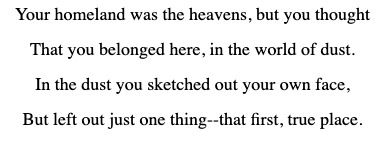
#1771

#57
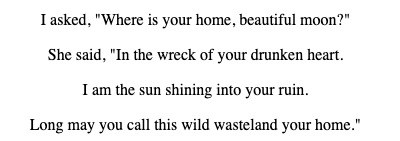
#1584

#1316
and the note on translation: these are of course not the Coleman Barks translations, the most popular English translations. i think the orientalism and... de-Sufi-fying and de-Muslim-ifying of the Barks translations and a lot of English-language and Western perception of Rumi is much more discussed now (Jawid Mojaddedi, who is writing a translation of Rumi's multi-volume Masnavi, says, "The Rumi that people love is very beautiful in English, and the price you pay is to cut the culture and religion.") if you're interested, Persian Poetics has a great twitter thread about it and their website has text, audio, and video resources where they've talked about it. and this article from Ajam Media is a short read and an interesting comparison of a few different translations.
if you enjoy Zara Houshmand's translations, she has a book of translations of Rumi's quatrains, Moon and Sun. there's many translations of Rumi's works not by Barks, that prioritise different things: you can 100% find a translation that isn't Barks, and Rumi's work is. so beautiful and so much better when you are not reading whatever uhhh... interpretation Barks came up with.
#image description in alt#poetry#text post#my post#fun fact in the same article i linked barks is quoted as saying#'the Qur'an is hard to read'#(yes i have changed the transliteration to Qur'an from the quote bc i'm sorry but i refuse to type it that way)#1 that's fucking bonkers to say as someone who has 'translated' Rumi's work like how are you openly admitting to that#and 2 the Masnavi quotes extensively from the Qur'an???#anyway i cannot begin to describe the shock i felt when i first came across 1 Rumi quatrains in the original Farsi where you can. physicall#see how much is missing from Barks' translation (and can identify common themes in those words if you can read any Arabic script)#and 2 when i read other translations for the first time and realised how much both God-as-figure and Islamic and Sufi tradition and#philosophy was missing#i was genuinely upset#it's... idk#when you are feeling that strange and deep ache and joy of love that is always mixed with the deep ache and joy of faith or God or etc#you gotta turn to Rumi yknow i need to remember that more often#i also haven't quoted from Mojaddedi's translation bc#i have honestly only seen bits and pieces of the Masnavi#if there's someone who has read more of it or can weigh in on the translation lmk#but like maybe one of my projects next year needs to be trying to read the first volume of that translation
7 notes
·
View notes
Text
is doing alt text at all encouraged in non-english spaces... I think it would make translation infinitely easier also
#i don't know that I've seen a non-english tweet with alt text.... if i have its very rare#i dont think twt translate does alt text but its still easier to manually put that into translate#than whatever method to try and get translations from images 💀 esp with handwriting#BUT HEY U SHOULD ALSO BE DOING ALT TEXT AS AN ENGLISH SPEAKER#i think ive been hesitant to add descriptions to other posts cos it makes them so long#but u know what. if they didnt want the post getting that long they should have PUT FUCKING ALT TEXT
4 notes
·
View notes
Text
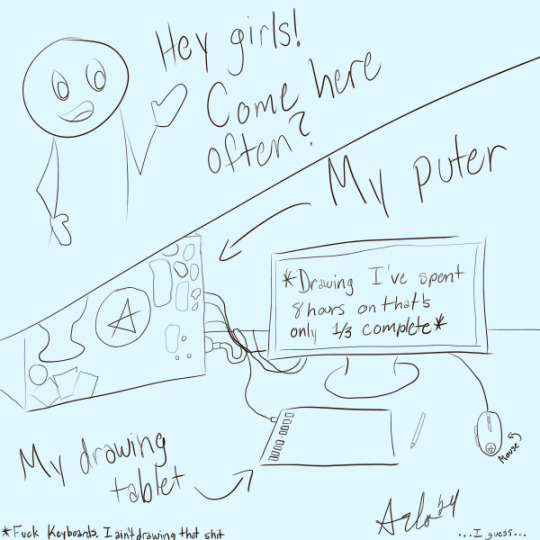
ive been working on the same project so long that ive twice lost the ability to make different line weights and had to take an extended break to regain that ability. this happened after the most recent time
sorry if you can't read my handwriting. i added alt text and you can use that to determine what my chicken scratch says
#enchanted dumbassery#enchanted scrawlings#image id in alt text#the worst part is that im doing this project for work AT HOME AND OFF THE CLOCK#i dont think i can even post it here bc it might doxx me#but yall can watch me suffer over it for funsies#artists on tumblr#doodle comic#i hope im not crazy from being tired and stressed and this translates to literally anyone#also i forgot to mention that my project is so huge i can only have two apps open at a time. the canvas is a 1:1 ratio of 168000 pixels
3 notes
·
View notes
Text
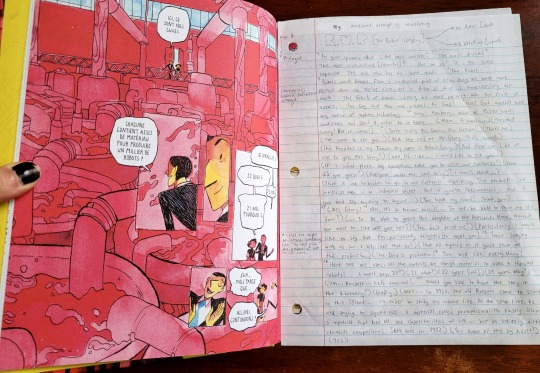
pretty brutal huh. well, im insane
#^ quote. thats a quote from another post.#original nonsense#personal#image described#im not actually sure what i will do with all this paper when i am done.#i was thinking of maybe like... scanning it and then plugging ot thru a photo to text program. and making the text available online?#no i dont know the legality of it. no it wouldnt make a lot of sense without the images. yes i wanna do it anyways.#i love this comic a lot i would like to share it somehow.... even if in sharing my english translation that might not be great.#<- since it was translated from czech to french and then english i assume the meaning will be warped over the course of languages...#rurposting
3 notes
·
View notes
Text
[ID: Black and red text on a cream background, reading first in Arabic: "لا تستطيع أن تقنع مستعمر الأمس أن مستعمر اليوم على خطأ", then in English: "You can't convince yesterday's colonizer that today's colonizer is wrong". End ID.]
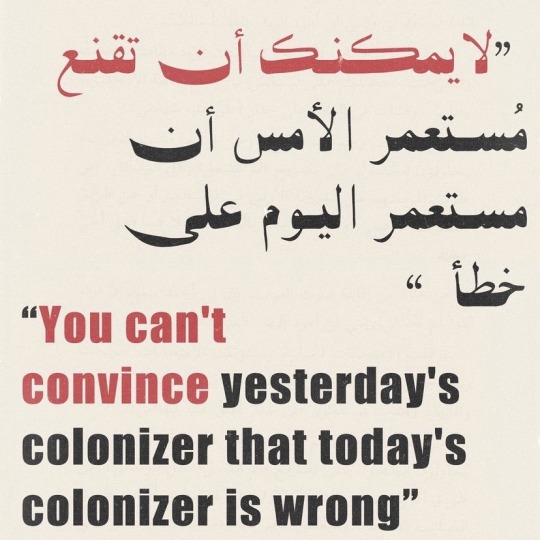
#Please copy and paste into the original post for accessability#no credit needed! It should just stay in plain text like it is now#without being put in italics bold or color#and go directly below the image#and above the caption#Image descriptions are for the visually impaired and blind#the way subtitles are for the deaf and hard of hearing#a plain text image description in the body of the post itself#is more accessible than just ALT text.#The image description should not go under a read more as that is inaccessible#and if you change your URL or delete the original post#everything under the read-more will be lost forever#I had to use google translate to get the text in Arabic so please let me know if there are any mistakes#this font makes it look different from the font google uses
11K notes
·
View notes
Text
i appreciated this study: "They Can't Read Very Well: A Study of the Reading Comprehension Skills Of English Majors At Two Midwestern Universities"
[ETA: if you are somehow finding your way here pls note some - not exhaustive!!!! - follow up notes in this reblog. sorry again i mixed up megalodons and megalosaurs]
essentially, a pair of professors set out to test their intuitive sense that students at the college level were struggling with complex text. they recruited 85 students, a mix of english majors and english education majors - so, theoretically, people focusing on literature, and people preparing to teach adolescents how to read literature - and had them read-while-summarizing the first seven paragraphs of dickens's bleak house (or as much as they made it through in the 20 minute session). they provided dictionaries and also said students could use their phones to look up whatever they wanted, including any unfamiliar words or references. they found that the majority of the students - 58%, or 49 out of the 85 students - functionally could not understand dickens at all, and only 5% - a mere 4 out of the 85 students - proved themselves proficient readers (leaving the remaining 38%, or 32 students, as what the study authors deemed "competent" students, most of whom could understand about half the literal meaning - pretty low bar for competence - although a few of whom, they note, did much better than the rest in this group if not quite well enough to be considered proficient).
what i really appreciated about this study was its qualitative descriptions of the challenges and reading behaviors of what the authors call "problematic readers" (that bottom 58%), which resonated strongly with my own experiences of students who struggle with reading. here's their blunt big picture overview of these 49 students:
The majority of these subjects could understand very little of Bleak House and did not have effective reading tactics. All had so much trouble comprehending concrete detail in consecutive clauses and phrases that they could not link the meaning of one sentence to the next. Although it was clear that these subjects did try to use various tactics while they read the passage, they were not able to use those tactics successfully. For example, 43 percent of the problematic readers tried to look up words they did not understand, but only five percent were able to look up the meaning of a word and place it back correctly into a sentence. The subjects frequently looked up a word they did not know, realized that they did not understand the sentence the word had come from, and skipped translating the sentence altogether.
the idea that they had so much trouble with every small piece of a text that they could not connect ideas on a sentence by sentence basis is very familiar to me from teaching and tutoring, as was the habit of thought seen in the example of the student who gloms on to the word "whiskers" in a sea of confusion and guesses incorrectly that a cat is present - struggling readers, in my experience, seem to use familiar nouns as stepping stones in a flood of overwhelm, hopping as best they can from one seemingly familiar image to the next. so was this observation, building off the example of a student who misses the fact that dickens is being figurative when he imagines a megalodon stalking the streets of london:
She first guesses that the dinosaur is just “bones” and then is stuck stating that the bones are “waddling, um, all up the hill” because she can see that Dickens has the dinosaur moving. Because she cannot logically tie the ideas together, she just leaves her interpretation as is and goes on to the next sentence. Like this subject, most of the problematic readers were not concerned if their literal translations of Bleak House were not coherent, so obvious logical errors never seemed to affect them. In fact, none of the readers in this category ever questioned their own interpretations of figures of speech, no matter how irrational the results. Worse, their inability to understand figurative language was constant, even though most of the subjects had spent at least two years in literature classes that discussed figures of speech. Some could correctly identify a figure of speech, and even explain its use in a sentence, but correct responses were inconsistent and haphazard. None of the problematic readers showed any evidence that they could read recursively or fix previous errors in comprehension. They would stick to their reading tactics even if they were unhappy with the results.
i have seen this repeatedly, too - actually i was particularly taken with how similar this is to the behavior of struggling readers at much younger ages - and would summarize the hypothesis i have forged over time as: struggling readers do not expect what they read to make sense. my hypothesis for why this is the case is that their reading deficits were not attended to or remediated adequately early enough, and so, in their formative years - the early to mid elementary grades - they spent a lot of time "reading" things that did not make sense to them - in fact they spent much more time doing this than they ever did reading things that did make sense to them - and so they did not internalize a meaningful subjective sense of what it feels like to actually read things.
like, i've said this before, but the year i taught third grade i had multiple students who told me they loved reading and then when i asked them about a book they were reading revealed that they had absolutely no idea what was going on - on a really basic literal level like "didn't know who said which lines of dialogue" and "couldn't identify which things or characters given pronouns referred to" - and were as best as i could tell sort of constructing their own story along the way using these little bits of things they thought they understood. that's what "reading" was, in their heads. and they were, in the curriculum/model that we used at the private school where i taught, receiving basically no support to clarify that that was not what reading was, nor any instruction that would actually help them with what they needed to do to improve (understand sentences) - and i realized over the course of that year that the master's program that had certified me in teaching elementary school had provided me with very little understanding of how to help these kids (with perhaps the sole exception of the class i took on communications disorders, not because these kids had communications disorders but because that was the only class where we ever talked, even briefly, about things like sentence structures that students may need instruction in and practice with to comprehend independently). when it comes to the literal, basic understanding of a text, the model of reading pedagogy i was taught has about 6 million little "tools" that all boil down to telling kids who functionally can't read to try harder to read. this is not productive, in my experience and opinion, for kids whose maximum effort persistently yields confusion. but things are so dysfunctional all the way up and down the ladder that you can be a senior in college majoring in english without anyone but a pair of professors with a strong work ethic noticing that you can't actually read.
couple other notes:
obviously it's a small study but i'm not sure i see a reason to believe these are particularly outlierish results (ACT scores - an imperfect metric but not a meritless one IMO for reading specifically, where the task mostly really is to read a set of texts written for the educated layperson and answer factual questions about them - were a little bit above the national average)
the study was published last year, but the research was conducted january to april 2015. so there's no pandemic influence, no AI issue - these are millennials who now would span roughly ages 28-32 (i guess it's possible one of the four first-year students was one of the very first members of gen z lol). if you're in your late 20s or early 30s, we are talking about people your age, and whatever the culprit is here, it was happening when you were in school.
i think some people might want to blame this on NCLB but i find this unconvincing for a variety of reasons. first of all, NCLB did not pass because everyone in 2001 agreed that education was super hunky-dory; in fact, the sold a story podcast outlines how an explicit goal of NCLB was to train teachers in systematic phonics instruction, because that was not the norm when NCLB was passed, and an unfortunate outcome was that phonics became politicized in ed world. second, anyone who understands anything about reading should need about ten minutes max to spend some time on standardized test prep and recognize that if your goal is truly to maximize scores... then the vast majority of your instructional time should be spent on improving actual reading skills because you actually can't meaningfully game these tests by "practicing main idea questions" (timothy shanahan addresses this briefly near the top of this post). so i find it very difficult to believe that any school that pivoted to multiple choice drill time in an attempt to boost reading scores was teaching reading effectively pre-NCLB, because no set of competent literacy professionals would think that would work even for the goal of raising test scores. third, NCLB mandated yearly testing in grades 3-8 but only one test year in high school; kansas set its reading and math test year in high school as tenth grade. so theoretically these kids all had two years of sweet sweet freedom from NCLB in which their teachers could have done whatever the fuck they wanted to teach these kids to actually read. the fact that they didn't suggests perhaps there were other problems afoot. fourth, and maybe most saliently for this particular study, the sample text was the first seven paragraphs of a novel - in other words, the exact kind of short incomplete text that NCLB allegedly demanded excessive time spent on. i'm not really sure what universe it makes sense in that students who can't read the first seven paragraphs of a novel would have become much better reader if everything else had been the same but they had been making completely wack associations based on nonsense guesses for all 300 pages instead. (if you read the study it's really clear that for problematic readers, things go off the rails immediately, in a way that a good program targeted at teaching mastery of text of 500 words or less would have done something about.)
all but 3 of the students reported A's and B's in their english classes and, again, 69% of them are juniors and seniors, so like... i mean idk kudos to these professors for being like "hold up can these kids actually read?" but clearly something is wack at the college level too [in 2015] if you can make your way through nearly an entire english major without being able to read the first seven paragraphs of a dickens novel. (once again i really do encourage you to look at the qualitative samples in the study, lest you think i am being uncharitable by summarizing understandable misunderstandings or areas of confusion that may resolve themselves with further exposure to the text as "can't read.") not to mention the fact that most students could not what they had learned in previous or current english classes and when asked to name british and american authors and/or works of the nineteenth century, roughly half the sample at each college could name at most one.
the authors of the study are struck by the fact that students who cannot parse the first 3 sentences of bleak house feel very confident about their ability to read the entire novel, and discover that this seeming disconnect is resolved by the fact that these students seem to conceptualize "reading" as "skimming and then reading sparknotes." i think it's really tempting to Kids These Days this phenomenon (although again these are people who in some cases have now been in the workforce for a decade) and categorize it as laziness or a lack of effort, but i think that there is, as i described above, a real and sincere confusion over what "reading" is in which this makes a certain logical sense because it's not like they have some store of actual reading experiences to compare it to. i also think it's pretty obvious looking at just how wildly severed from actual textual comprehension their readings are that these are not - or at least not entirely - students who could just work harder and master the entirety of bleak house all on their own. like i don't think you get from "charles dickens is describing a bunch of dinosaur bones actually walking the streets of london" to comfortably reading nineteenth century literature by just trying harder. i really just don't (and i say that acknowledging i personally have had students who like... were good readers if i was forcing them to work at it constantly... but i have also had students, including ones getting ready to enter college, who were clearly giving me everything they had and what they had was at the present moment insufficient). i think that speaks to a missing skillset that they don't know are missing, because they don't have any other experience of "reading" to compare it to.
just wanna highlight again that although they don't give the breakdown some of these students are not just english majors but english education majors a.k.a. the high school english teachers of tomorrow. some of them may be teaching high school english right now, in case anyone wishes to consider whether "maybe some high school english teachers can't read the first seven paragraphs of bleak house?" should be kept in mind when we discuss present-day educational ills.
15K notes
·
View notes
Text
Image to Text | Extract Text from Image | Search using Web Detailed video on TECH ALERT : https://youtu.be/2R7Nn7GyLdU #techalert #technical #howto #translate #translation #google #translategoogle #googletranslate #typing #jobs #tipsandtricks #instagram #trending #viral #yotubeshorts #youtube #fb #love
#Image to Text | Extract Text from Image | Search using Web#Detailed video on TECH ALERT : https://youtu.be/2R7Nn7GyLdU#techalert#technical#howto#translate#translation#google#translategoogle#googletranslate#typing#jobs#tipsandtricks#instagram#trending#viral#yotubeshorts#youtube#fb#love#watch video on tech alert yt#like#technology#shorts#instagood
1 note
·
View note
Text
🚀 The ChatGPT Desktop App is Changing the Game! 🤯💻 Imagine having an AI assistant that can: ✅ Reply to emails in seconds 📧⏩ ✅ Generate high-quality images with DALL-E 🎨🤩 ✅ Summarize long content instantly 📖📜 ✅ Write HTML/CSS code from screenshots 💻💡 ✅ Translate text across multiple languages 🌍🗣️ ✅ Extract text from images easily 📷📝 ✅ Analyze large datasets from Excel/CSV files 📊📈 👉 This app is designed to save your time. #ChatGPT #ChatGPTDesktopApp #AIProductivity #dalle #TechT
#AI automation#AI content creation#AI email management#AI for business#AI productivity tool#AI social media engagement#automatic code generation#ChatGPT benefits#ChatGPT coding#ChatGPT content summarization#ChatGPT desktop app#ChatGPT email replies#ChatGPT features#ChatGPT for professionals#ChatGPT tools for professionals.#ChatGPT uses#content summarization#DALL-E image generation#data analysis with AI#simplify daily tasks#smart translation#social media automation#text extraction from images
1 note
·
View note
Text
In English:
CALIFORNIA IMMIGRANT POLICY CENTER - DEFEND IMMIGRANTS
California Rapid Response Networks
Northern California
Central del Pueblo Rapid Response Network (Humboldt County) - Hotline: 707-200-8091
Sacramento Rapid Response Network - Hotline: 916-382-0256
Bay Area
Alameda County Immigration Legal and Education Partnership (ACILEP) - Hotline: 510-241-4011
Marin Rapid Response Network - Hotline: 415-991-4545
North Bay Rapid Response Network (Sonoma, Napa & Solano Counties) - Hotline: 707-800-4544
San Francisco Rapid Response Network - Hotline: 415-200-1548
San Mateo County Rapid Response Network - Hotline: 203-666-4472
Santa Clara County Rapid Response Network - Hotline: 408-290-1144
Stand Together Contra Costa - Hotline: 925-900-5151
Central Coast & Central Valley
Kern County Rapid Response Network - Hotline: 661-432-2230
Santa Cruz County Your Allied Rapid Response Network & Pajaro Valley Rapid Response - Hotline: 831-239-4289
Southern Central Coast Rapid Response Network (Santa Barbara, Ventura & San Luis Obispo Counties) - Hotline: (805) 870-8855
Valley Watch Rapid Response Network (Fresno, San Joaquin, Merced, Stanislaus, and Kern Counties) - Hotline: 559-206-0151
Monterey Rapid Response Network (Monterey County) - Hotline: 831-204-8082
Southern California
ÓRALE (City of Long Beach) - Hotline: 562-245-9575, Website: www.orale.org
Los Angeles Rapid Response Network - Hotline: 888-624-4752
Orange County Rapid Response Network - Hotline: 714-881-1558, Email: [email protected]
(San Bernardino & Riverside Counties) Inland Coalition For Immigrant Justice's Resource - Hotline: 909-361-4588
Southern California Bilingual Rapid Response Legal Resource Hotline (if detained by ICE) - Hotline: 213-833-8283
San Diego
(North County San Diego) Alianza Comunitaria - Text Alerts for Checkpoints: Envía "Alianza" al 33733 para español/Send "Alianza2" to 33733 for English
San Diego Rapid Response Network - Hotline: 619-536-0823
Additional Resources
Videos: We Have Rights (English, Spanish, Arabic, Mandarin, Haitian Creole, Russian, Urdu)
Referrals: Deportation Defense Legal Services & Immigration Legal Services (DACA, TPS, Citizenship, etc.)
Know Your Rights Materials
Know Your Rights Under the US Constitution - No Matter Who is President (NILC)
A know-your-rights handout in eight languages to help families prepare for a possible interaction with ICE
A Know Your Rights Toolkit by ILRC includes handouts, family preparedness plans and a train-the-trainer toolkit
Printable ILRC red cards in to distribute to community members (Spanish here)
Know-Your-Rights tutorial videos in 7 languages to help prepare individuals for encounters with Immigration & Customs Enforcement (ICE) (Spanish here) • CLINIC Know Your Rights flyers
WeHaveRights - Creating an Emergency Plan
Noncitizen Protest Protection: 10 Things Noncitizen Protestors Need to Know KYR/Community Education Preparedness Resources (NIPNLG)
Know Your Rights and Creating Safe Spaces Resource List (NILC)
Know Your Rights Resources (NIJC)
Deportation & Removal Defense
Building Community-Driven Legal Services to Empower, Protect, and Defend Our Communities: Field Guide for Deportation Defense
Deportation Defense Manual (Make the Road NY)
Community FAQ: What Do We Expect at the Beginning of Trump 2.0 & How You Can Get Prepared (NIPNLG)
KYR Community Education Materials
KYR/ Community Education Preparedness - Curated Resources (NIPNLG) KYR Flyer - English (NPNA)
KYR Graphics - English (NPNA)
KYR Community Education Presentation - English
KYR Community Education Presentation - Spanish
Train the Trainer KYR Presentation Outline (1 Hour) - English
Train the Trainer KYR Presentation Outline (1 Hour) - Spanish
ILRC Know Your Rights Train the Trainer Toolkit
TRP Immigrant Justice KYR Resources
NAKASEC Resources & Know Your Rights App
Family Preparedness
ILRC Family Preparedness Plan (English/Spanish)
Family Preparedness Plan (TIRRC)
Appleseed Manual on Protecting Assets Family Preparedness 2 Pager (NPNA)
Family Preparedness 2 Pager - Spanish (NPNA)
Family Preparedness Graphic Carousel (NPNA)
Explore more at cipc.me/KYR (This link is broken; attached below is an operational page)
HAVE YOU SEEN ICE IN YOUR NEIGHBORHOOD?
Document it and report it.
CALL THE LA RAPID RESPONSE NETWORK AT: 1-888-624-4752
────
En Español:
CALIFORNIA IMMIGRANT POLICY CENTER - DEFENDAMOS A LOS INMIGRANTES
Redes de Respuesta Rápida de California
Norte de California
Red de Respuesta Rápida de Central del Pueblo (Condado de Humboldt) - Linea: 707-200-8091
Red de Respuesta Rápida de Sacramento - Línea: 916-382-0256
Área de la Bahía
Red de Respuesta Rápida del Condado de Alameda (ACILEP) - Linea: 510-241-4011
Red de Respuesta Rápida de Marin - Linea: 415-991-4545
Red de Respuesta Rápida del Norte de la Bahia (Condados de Sonoma, Napa, y Solano) - Línea: 707-800-4544
Red de Respuesta Rápida de San Francisco - Línea: 415-200-1548
Red de Respuesta Rápida del Condado de San Mateo - Linea: 203-666-4472
Red de Respuesta Rápida del Condado de Santa Clara - Línea: 408-290-1144
Stand Together Contra Costa - Línea: 925-900-5151
Costa Central y Valle Central
Red de Respuesta Rápida del Condado de Kern - Linea: 661-432-2230
Su Red de Respuesta Rápida Aliada de los Condados de Santa Cruz y Pájaro Valley - Línea: 831-239-4289
Red de Respuesta Rápida del Sur de la Costa Central (Condados de Santa Bárbara, Ventura, y San Luis Obispo) - Línea: 805-870-8855
Red de Respuesta Rápida Valley Watch (Condados de Fresno, San Joaquín, Merced, Stanislaus, y Kern) - Línea: 559-206-0151
Red de Respuesta Rápida de Monterey (Condado de Monterey) - Línea: 831-204-8082
Sur de California
Órale (Ciudad de Long Beach) - Linea: 562-245-9575, Sitio: www.orale.org
Red de Respuesta Rápida de Los Ángeles - Linea: 888-624-4752
Red de Respuesta Rápida del Condado de Orange - Linea: 714-881-1558, Correo electrónico: [email protected]
(Condados de San Bernardino y Riverside) Recurso de la Coalición del Interior Por la Justicia Inmigrante (ICIJ) - Linea: 909-361-4588
Red Bilingüe de Respuesta Rápida de Recursos Legales del Sur de California (Si es detenide por ICE) - Línea: 213-833-8283
San Diego
(Norte del Condado de San Diego) Alianza Comunitaria - Alertas de Texto por Retenes: Envie "Alianza" al 33733 para español o Alianza2 a 33733 para inglés
Red de Respuesta Rápida de San Diego - Línea: 619-536-0823
Recursos Adicionales
Videos: Tenemos Derechos (Disponible en inglés, español, árabe, mandarin, creole haitiano, ruso, urdů)
Referencias: Servicios Legales de Defensa contra la Deportación y Servicios Legales de Inmigración (DACA, TPS, Ciudadanía, etc)
Materiales de Conozca Sus Derechos
Sepa Sus Derechos bajo la Constitución Estadounidense - Sin Importar Quién Sea Presidente (NILC)
Volante de Conozca Sus Derechos en ocho idiomas para ayudarle a familias prepararse para posibles interacciones con ICE
Una colección de Conozca Sus derechos por ILRC que incluye volantes, planes de preparación familiar, y una capacitación de promotor
Tarjetas rojas imprimibles del ILRC para distribuir (incluyendo en español)
Videos de Conozca Sus Derechos en 7 idiomas para preparar a individuos con encuentros con ICE en español
Volantes CLINIC Conozca Sus Derechos
WeHaveRights (Tenemos Derechos) Creando un Plan de Emergencia
Protección de Arrestos a No-Ciudadanos: 10 Cosas que Deben Saber los No Ciudadanos
Conozca sus Derechos - Recursos de Educación y Preparación Comunitaria (NIPNLG)
Lista de Recursos de Conozca Sus Derechos y Creando Espacios Seguros (NILC)
Recursos de Conozca sus Derechos (NIJC)
Defensa de Deportación
Construyendo Servicios Liderados por la Comunidad para Empoderar, Proteger, y Defender Nuestras Comunidades: Guía de Campo para Defensa de Deportación
Manual de Defensa de Deportación (Make the Road NY)
Preguntas Comúnmente Hechas por La Comunidad: Qué Esperar del Comienzo de Trump 2.0 y Cómo se Puede Preparar (NIPNLG)
Materiales de Educación Comunitaria de Conozca sus Derechos (CSD)
CSD. Preparación Comunitaria - Recursos (NIPNLG)
Volante CSD - en inglés (NPNA)
Gráficas CSD- en inglés (NPNA)
Presentación de Educación Comunitaria CSD- en inglés
Presentación de Educación Comunitaria CSD- en español
Guión de Presentación de Capacitación de Promotor Conozca Sus Derechos (1 hora) en inglés
Guión de Presentación de Capacitación de Promotor Conozca sus Derechos (1 hora) en español
ILRC Materiales de Capacitación de Promotor de Conozca sus Derechos
Recursos de Conozca Sus Derechos TRP Justicia Inmigrante
Recursos y Aplicación Conozca Sus Derechos NAKASEC
Preparación Familiar
Plan de Preparación Familiar (TIRRC) Manual Appleseed de Proteger sus Bienes
Documento de Preparación Familiar (NPNA)
Documento de Preparación Familiar (NPNA) - en español
Carrusel de Gráficas de Preparación Familiar (NPNA)
Explore más en cipc.me/KYR (Este enlace no funciona; a continuación se adjunta una página operativa en inglés):
CHAS VISTO A INMIGRACIÓN EN LOS ANGELES?
¡Documéntalo y repórtalo!
LLAMA A LA RED DE RESPUESTA RÁPIDA DE LOS ANGELES AL: 1-888-624-4752










resources to protect immigrants in LA from ICE ‼️
#txt#important#save for later#long post#apologies if the added bit about the link is wrong!#i used a program to extract the text from the images then had to manually translate that disclaimer ^^;
2K notes
·
View notes
Text

Development files for Yoshi's Island contain this bizarre text that appears to be someone's personal account of buying a TV (translated from Japanese in the image).
What this is doing inside the files, and whether it was ever meant to be used as part of development itself (such as e.g. as a test message) or whether it was completely unrelated and simply ended up there as a mistake, is unknown.
Main Blog | Patreon | Twitter | Bluesky | Small Findings | Source: GlitterBerri
2K notes
·
View notes